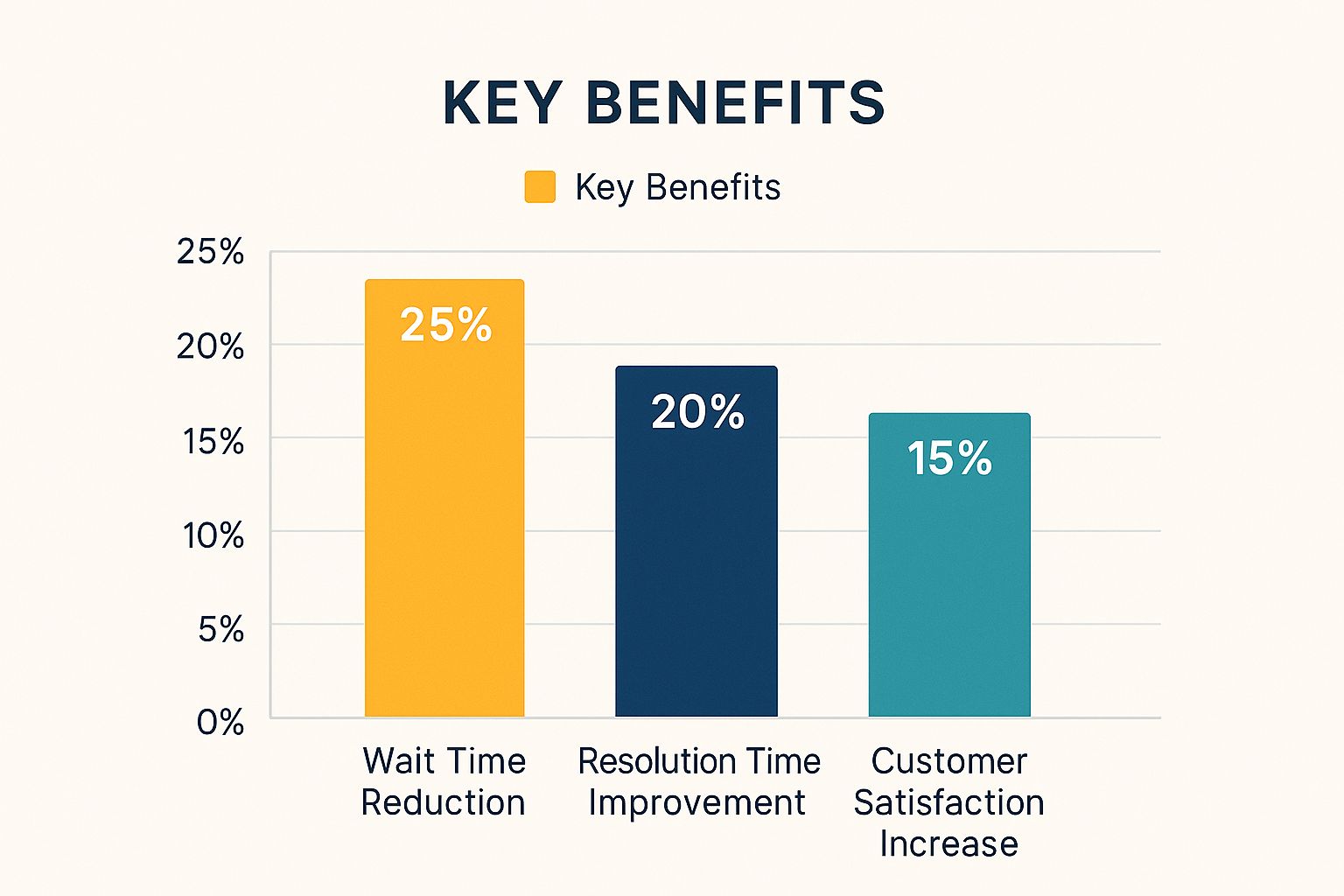The Evolution of Intelligent Call Routing in Australia

Remember the days of navigating confusing phone menus, only to be transferred to the wrong department? For Australian businesses and customers, this frustrating experience is becoming a thing of the past. This positive shift is largely thanks to intelligent call routing, a technology that's changing how we connect.
From Basic Queues to AI-Powered Solutions
Early call routing in Australia relied on simple queues and pre-set rules. Calls were often distributed based on which agent was available, leading to long wait times and multiple transfers. This method lacked the flexibility and personalization needed to handle a variety of customer questions effectively. As customer expectations grew, businesses needed better solutions.
This demand led to skills-based routing, connecting callers with agents who had the right skills for their specific questions. This improved efficiency and customer happiness, but it didn't consider individual customer history or preferences. The next big step, intelligent call routing, solves these problems. Intelligent routing uses AI and machine learning (Machine Learning) to analyze large amounts of data, like customer profiles, past interactions, and even real-time sentiment analysis.
This data-driven approach helps businesses personalize customer experiences. By 2025, Australian companies, especially in the service industry, are expected to increasingly use AI to improve customer experiences. AI-powered call routing, for instance, can analyze customer history and the type of issue to connect them with the best agent, reducing transfers and improving resolution times. Learn more about 2025 trends in Australian Service Industry. This not only streamlines operations, but also makes customers much happier. For example, AI can handle repetitive questions, freeing up human agents to focus on complex issues. This boosts both agent productivity and job satisfaction. This advanced routing leads to happier customers and helps businesses use resources better and improve overall efficiency.
Why Intelligent Call Routing Matters in Australia
Australia's large size and diverse population create unique challenges for businesses trying to provide excellent customer service. Intelligent call routing addresses these challenges by quickly connecting customers with the right agent, no matter where they are or their background. This personalized service is key to building strong customer relationships and loyalty in the Australian market. The growing need for 24/7 service and the increase in mobile interactions demand a smarter way to manage calls. This makes intelligent call routing a vital investment for businesses that want to succeed.
Measurable Benefits That Drive Business Growth
Intelligent call routing isn't just a buzzword; it delivers tangible benefits that directly affect your profits. Australian businesses using this technology are seeing major improvements in key performance indicators. This means happier customers, increased efficiency, and ultimately, more business growth.
Real-World Impact: How Intelligent Routing Transforms Businesses
Intelligent call routing allows for precision matching, linking customers with the best agent based on their individual needs. This focused method minimizes transfers, reduces customer frustration and shortens handling times. For instance, a customer with a complex technical issue goes straight to a specialized agent, skipping the general queue and getting their problem solved faster. By analyzing customer history and intent, intelligent routing anticipates needs and proactively connects customers with the right resources.
This personalized approach creates more meaningful customer journeys. By addressing needs quickly and effectively, businesses cultivate stronger customer relationships and encourage loyalty. This translates to returning customers and positive word-of-mouth referrals, contributing to lasting growth. Improved first-call resolution rates reinforce these benefits, addressing customer concerns efficiently.

The infographic above highlights the key advantages of intelligent call routing: a 25% reduction in wait times, a 20% improvement in resolution times, and a 15% increase in customer satisfaction. These improvements demonstrate the positive impact on customer experience and operational efficiency. Shorter wait times lead to happier customers, and faster resolutions allow agents to handle more calls, increasing overall productivity.
Transforming Operational Efficiency: From Transfers to Handling Times
Intelligent call routing boosts operational efficiency in several ways. First, by reducing transfers, it allows agents to concentrate on solving problems rather than navigating internal processes. This also contributes to shorter handling times, as agents are prepared to address specific needs immediately.
Second, intelligent routing improves workload balancing. By distributing calls based on agent expertise and availability, it prevents agent overload and ensures consistent performance and job satisfaction. This creates a balanced and effective work environment for your team, leading to positive customer interactions and a stronger brand image. The data from intelligent routing systems offers valuable insights into customer behavior and common questions. This information helps improve training, refine processes, and optimize service delivery.
To illustrate the benefits, let's look at a comparison:
Key Benefits of Intelligent Call Routing
A comparison of traditional routing systems versus intelligent call routing across key performance indicators.
| Performance Metric | Traditional Call Routing | Intelligent Call Routing | Improvement Percentage |
|---|---|---|---|
| Average Wait Time | 5 minutes | 3.75 minutes | 25% |
| Average Resolution Time | 10 minutes | 8 minutes | 20% |
| Customer Satisfaction | 75% | 86.25% | 15% |
| First Call Resolution Rate | 60% | 75% | 25% |
| Agent Transfer Rate | 20% | 5% | 75% |
This table clearly shows how intelligent call routing significantly improves key metrics, from wait times and resolution rates to overall customer satisfaction. Implementing intelligent routing leads to a better experience for both customers and your team.
Ultimately, intelligent call routing empowers businesses to offer better service while improving efficiency—a win-win for everyone.
The Hidden ROI: Transforming Agent Experience

Your contact center agents are the voice of your business. But are they truly equipped to handle every interaction effectively? Intelligent call routing empowers your agents to excel by connecting them with the right customers at the right time. This creates a more positive and productive work environment, leading to a happier, more stable team.
Happier Agents, Better Performance
Think about it: agents constantly dealing with misrouted calls become frustrated and disengaged. This frustration directly impacts their performance and contributes to high turnover, a common problem for Australian service teams.
However, when agents receive calls aligned with their skills and expertise, their job satisfaction increases dramatically. Studies show a 62% increase in job satisfaction among agents receiving properly matched inquiries. This satisfaction translates into improved performance, with a 47% boost in key performance metrics observed in these same agents.
These statistics clearly demonstrate the link between intelligent call routing, agent well-being, and improved business outcomes. Additionally, intelligent call routing fosters a sense of purpose among agents. By connecting them with customers who genuinely need their specific skills, agents make a real difference in every interaction. This sense of value significantly boosts morale and creates a more positive work environment.
Intelligent call routing can significantly improve business growth. If you are considering other marketing channels like SMS marketing, analyzing your potential ROI is crucial.
Reducing Burnout and Improving Customer Connections
AI-powered workload balancing is another crucial benefit of intelligent call routing. Instead of overwhelming some agents while leaving others idle, the system intelligently distributes calls based on availability and expertise.
This even distribution prevents burnout and ensures all agents have a manageable workload, leading to improved focus and better customer interactions. This improvement in workload management, coupled with more meaningful customer connections, creates a positive feedback loop.
Agents feel more valued, customers receive better service, and the business benefits from increased efficiency and customer loyalty. By 2025, intelligent call routing is predicted to be a key strategy for improving operational efficiency in Australian contact centers. By automating call routing, companies ensure customers reach the right agent based on their needs, reducing escalations and resolution times.
This provides faster, more personalized service and frees agents from repetitive tasks. AI routing can save agents approximately 1.2 hours of productivity per day, allowing them to tackle more complex and fulfilling tasks. This efficiency boost leads to happier agents and a better overall customer experience. More detailed statistics can be found here. This focus on agent well-being through intelligent call routing creates a more sustainable and skilled team, ultimately delivering consistently superior customer experiences.
Implementing Intelligent Call Routing Without Disruption
Transforming your call routing system doesn't have to be a complex undertaking. This guide provides a practical approach for Australian businesses to implement intelligent call routing smoothly and efficiently. We'll explore the key technologies involved, compare different implementation methods, and discuss how to integrate this powerful tool into your current setup.
Understanding the Core Technologies
Intelligent call routing relies on a few key technologies. Natural Language Processing (NLP) enables the system to interpret the caller's intent by analyzing their words. For instance, if a customer calls inquiring about "billing issues," NLP can pinpoint their need and route them to the billing department.
Machine learning refines this process by learning from previous calls. The system becomes more accurate and efficient over time. Some systems also use predictive analytics to anticipate customer needs based on factors like their call history and current interactions.
Cloud-Based vs. On-Premise Solutions
Selecting the right deployment model is essential. Cloud-based solutions offer flexibility and scalability, allowing you to adapt to evolving business requirements. Salesforce Service Cloud is a popular example of a cloud-based solution. On the other hand, on-premise solutions offer greater control over your data, which is a crucial factor for data sovereignty, a key concern for Australian businesses. Avaya OneCloud CCaaS offers both cloud and on-premise options.
To help illustrate the differences, let's look at the following table:
To help you choose the right approach, we've compiled a comparison of different implementation strategies. This table highlights the key differences between cloud-based and on-premise solutions based on factors such as business size, existing infrastructure, and budget.
Intelligent Call Routing Implementation Approaches
| Implementation Approach | Best For | Timeline | Complexity | Cost Range | Key Considerations |
|---|---|---|---|---|---|
| Cloud-Based | Businesses of all sizes seeking rapid deployment and scalability | Weeks to Months | Low to Medium | Subscription-based | Data sovereignty, integration with existing systems |
| On-Premise | Larger enterprises with strict data control requirements | Months to Years | Medium to High | Higher upfront investment | Maintenance, IT infrastructure requirements |
As you can see, each approach has its own set of advantages and disadvantages. Choosing the best fit depends on your specific business needs and available resources. Carefully evaluate factors like budget, existing IT infrastructure, and data security requirements.
Integrating with Your Existing Tech Stack
Your intelligent call routing system should seamlessly integrate with your existing setup, including your CRM and phone system. This integration ensures a smooth data flow and minimizes disruptions.
Many providers offer APIs and integration tools to simplify this process. Collaborate closely with your chosen vendor to develop a comprehensive integration strategy that minimizes downtime and ensures compatibility. Integrating with your CRM, for example, allows the system to access customer data and personalize each interaction.
Realistic Timelines and Resource Requirements
Implementation timelines vary depending on your chosen system's complexity and the size of your business. Smaller businesses can often implement cloud-based solutions within a few weeks, while larger deployments may require several months. Resource requirements also vary. Cloud-based solutions generally need less internal IT support, whereas on-premise systems require more dedicated resources for installation and ongoing maintenance. Understanding these factors upfront allows you to plan accordingly and minimize potential disruptions during implementation, ensuring a smooth transition and rapid access to the benefits of intelligent call routing.
Unlocking Customer Insights Through Data-Driven Routing

Intelligent call routing systems are moving beyond simply directing calls. They're becoming powerful tools that transform customer data into actionable insights. Leading Australian businesses are using this data to make better routing decisions, ultimately creating improved customer experiences. Think of intelligent call routing as a specialized type of Automated Ticket Routing, but specifically designed for voice interactions.
Using Data to Personalize the Customer Journey
This data-driven method uses information like past interactions and even real-time sentiment analysis to create a truly personalized customer experience. Imagine a customer calling about a recent purchase. The system recognizes their phone number, pulls up their purchase history, and routes them straight to an agent specializing in post-sales support. This personalized touch significantly reduces wait times and improves first-call resolution rates.
Furthermore, predictive analytics can anticipate customer needs before they're even voiced. For instance, if a customer frequently calls about a particular product feature, the system can proactively route their next call to an agent fully trained on that feature. This type of proactive service creates a stronger, more personal customer relationship.
Continuous Improvement Through Analytics
Data analysis plays a vital role in continually refining routing rules. By analyzing call data, businesses can identify important trends, pinpoint areas needing improvement, and adjust their routing strategies accordingly. This ongoing refinement creates increasingly effective customer journeys.
This means identifying peak call times, understanding common customer questions, and optimizing agent scheduling for maximum efficiency. Data analysis also helps identify any knowledge gaps within the team, enabling targeted training programs and improving overall service quality.
While specific Australian data on intelligent call routing may be historically limited, the wider use of AI in Australian customer service is well documented. AI is transforming how companies interact with customers, with AI-powered tools like chatbots and real-time sentiment analysis becoming increasingly common. This automation helps reduce handling times and improves efficiency. For example, by providing more accurate wait times, it can help reduce the average call center abandonment rate, which typically sits between 12% to 20%. Explore this topic further here.
Ethical Considerations and Privacy Compliance
As businesses use customer data for intelligent routing, it's crucial to address ethical considerations and fully comply with Australian privacy regulations. Transparency with customers about how their data is used is absolutely essential.
Businesses must ensure robust data security and implement strong safeguards to protect customer information. This includes adhering to regulations such as the Privacy Act 1988 and the Australian Privacy Principles. Following these guidelines builds customer trust and ensures responsible data use.
This commitment to ethical data practices strengthens customer relationships and maintains a positive brand reputation. By prioritizing data privacy and transparency, businesses can fully utilize the benefits of data-driven routing while preserving and strengthening customer trust.
Future-Proofing Your Intelligent Call Routing Strategy
The world of intelligent call routing is constantly evolving. Is your Australian business prepared for what's next? This section explores exciting new technologies set to reshape how we deliver exceptional customer experiences in Australia, focusing on how these advancements can help your business thrive in the coming years.
Voice Biometrics and Hyper-Personalization
Voice biometrics is rapidly transforming how we verify callers. This technology analyzes the unique characteristics of a person's voice to confirm their identity, eliminating the need for cumbersome security questions and PINs. This results in a faster, more secure, and more convenient experience for customers. Imagine a customer calling their bank and being instantly verified by their voice, streamlining the authentication process and reducing frustration.
Beyond enhanced security, voice biometrics unlocks the potential for hyper-personalization. By immediately identifying the caller, businesses can access their profile and history, tailoring the interaction to their specific needs and preferences. This could involve routing the call to an agent specializing in their past inquiries or presenting personalized product recommendations.
Omnichannel Routing: Beyond the Phone Call
Intelligent routing is expanding beyond traditional phone calls to encompass a true omnichannel experience. This involves seamlessly integrating various communication channels like messaging apps, social media platforms, and even email into a unified routing system. Consider a customer initiating contact through web chat who can then be seamlessly transferred to a phone call with the appropriate agent if their issue requires a more in-depth conversation.
This integrated approach provides customers with a consistent and convenient experience, no matter their chosen communication method. As customer preferences continue to shift toward digital communication, omnichannel routing becomes essential for businesses looking to maintain a competitive edge.
Emotional Intelligence and Personality Matching
Emerging technologies are incorporating emotional intelligence into intelligent call routing. This involves analyzing a caller's tone of voice and language to assess their emotional state. This information helps route the call to an agent best suited to handle the caller's specific emotional needs. A frustrated customer, for instance, could be routed to an agent known for their patience and de-escalation skills.
In addition, personality matching algorithms are being developed to pair callers with agents who have compatible communication styles. This creates a more natural and productive conversation, leading to increased customer satisfaction and higher resolution rates. The result is better customer experiences and improved agent job satisfaction, creating a more positive work environment.
Strategic Investments for the Future
To remain competitive, Australian businesses must invest strategically in these emerging technologies. This includes:
- Investing in robust AI and machine learning capabilities: These technologies underpin modern intelligent call routing systems.
- Prioritizing data security and privacy: As data becomes increasingly central to call routing, protecting customer information is paramount. Adhering to Australian privacy regulations and ensuring transparency with customers are crucial for building and maintaining trust.
- Building a culture of continuous improvement: Regularly analyzing call data and refining routing rules ensures your system remains optimized and effective.
By focusing on these key areas, businesses can prepare for the future of intelligent call routing and position themselves as leaders in customer experience excellence in Australia.
Ready to transform your customer experience and empower your team? Explore the possibilities of intelligent call routing with OnSilent today! Learn more about OnSilent.

